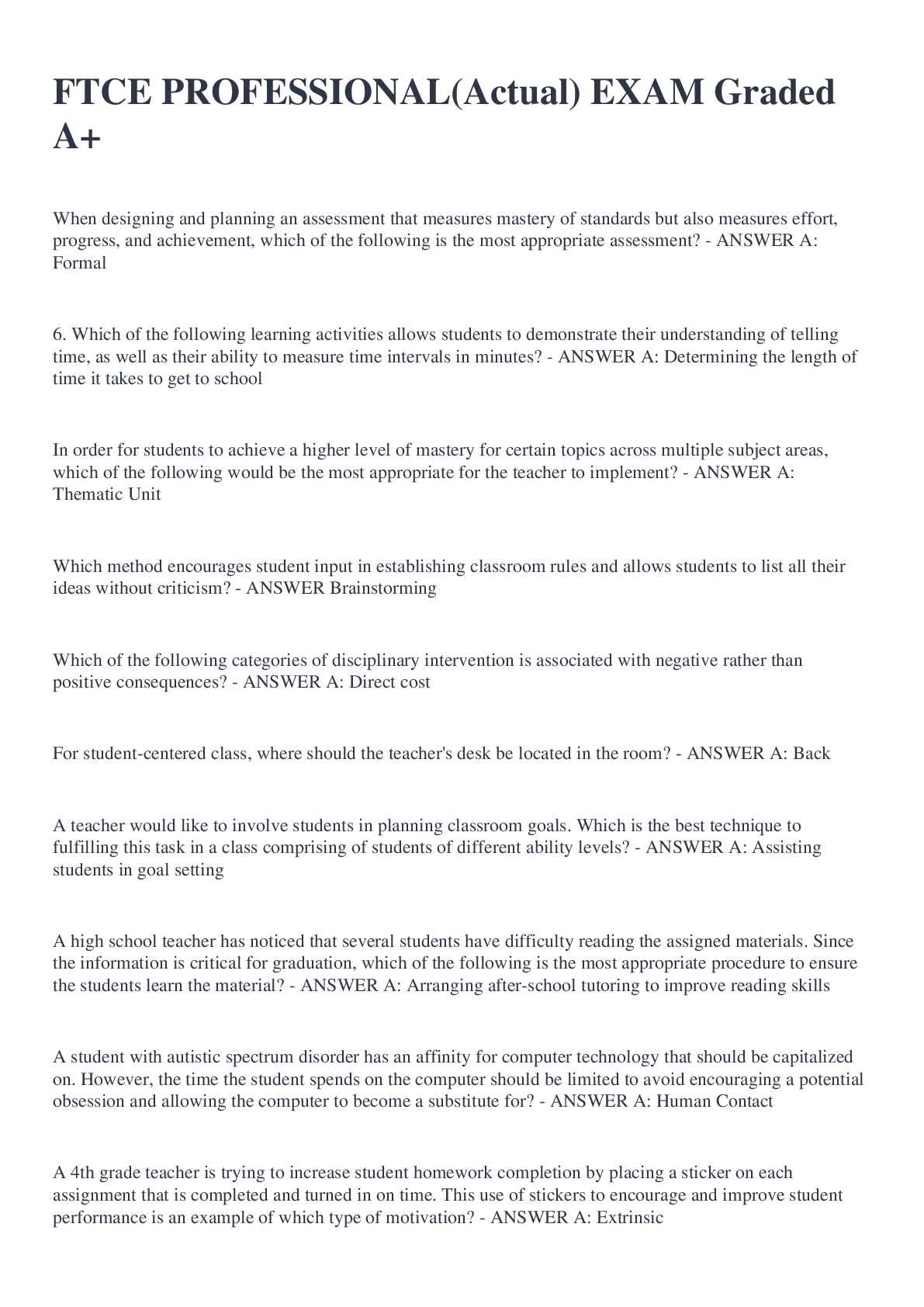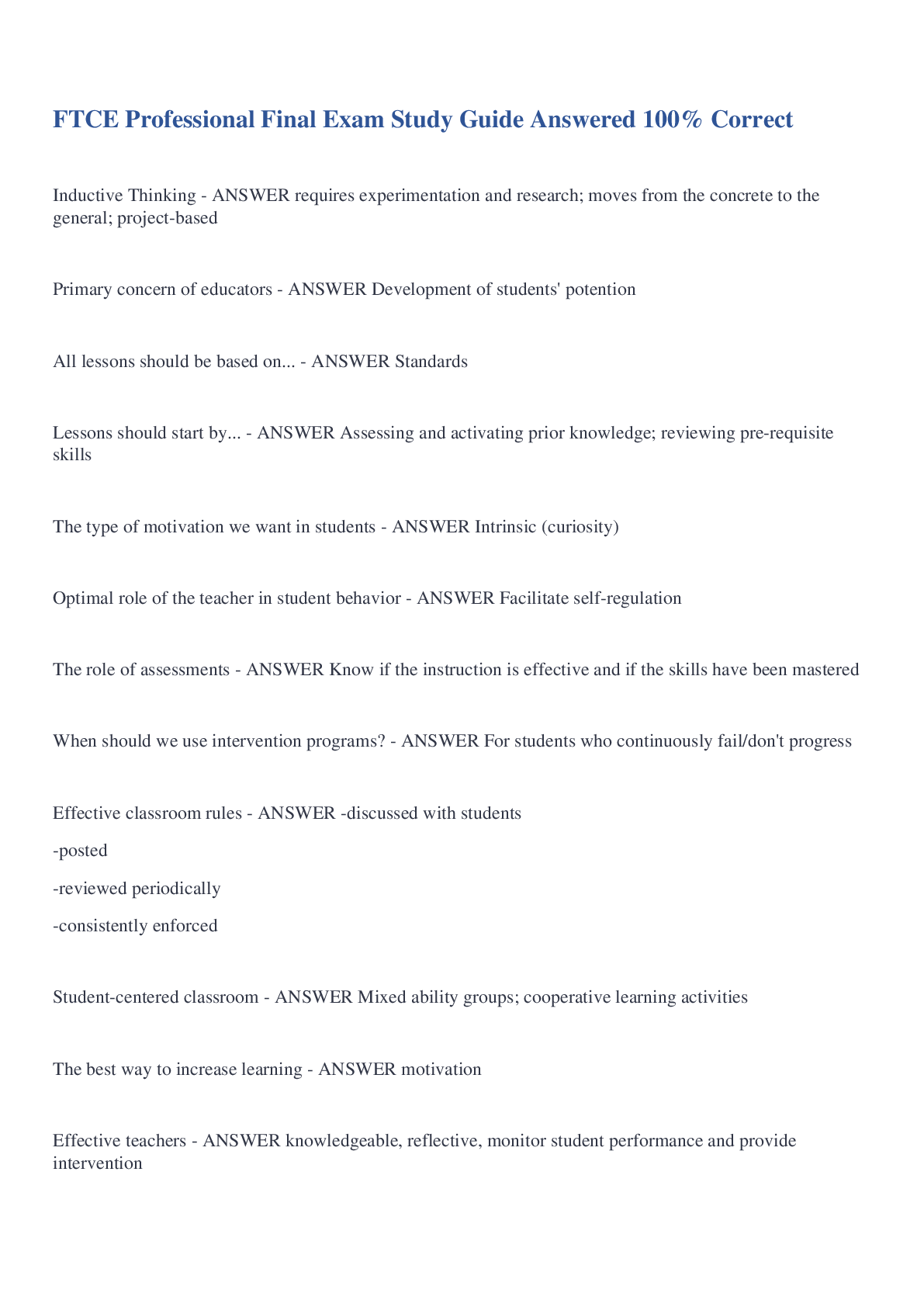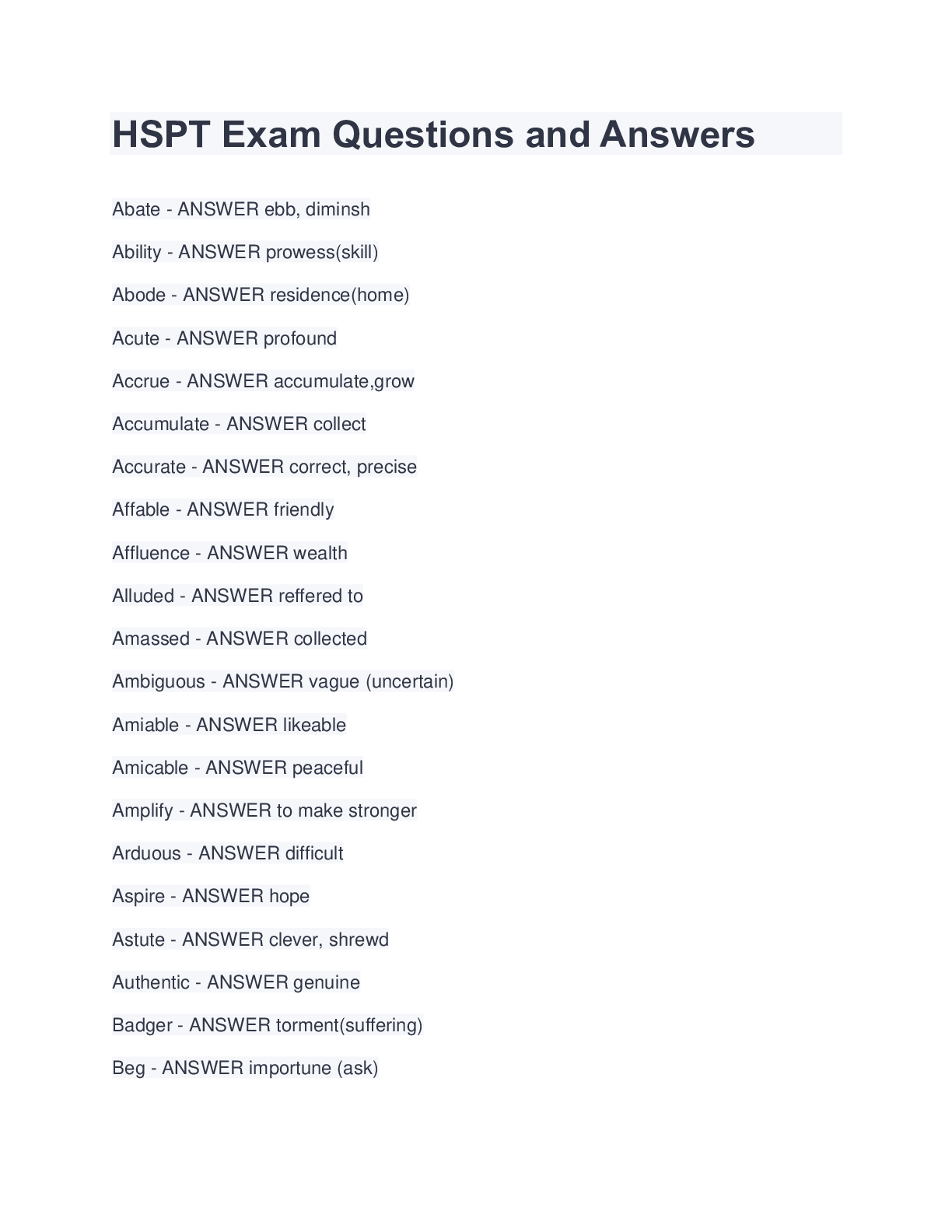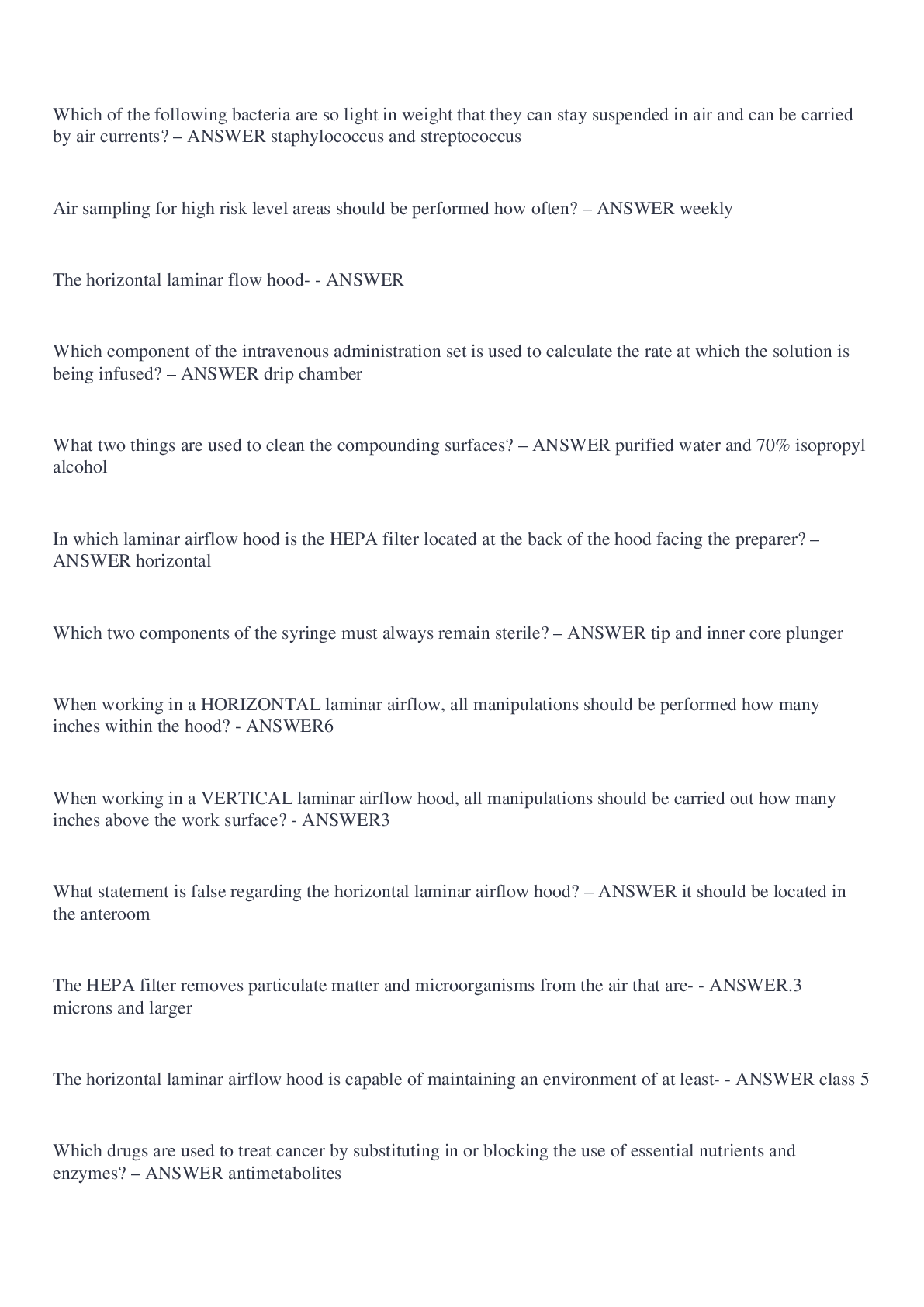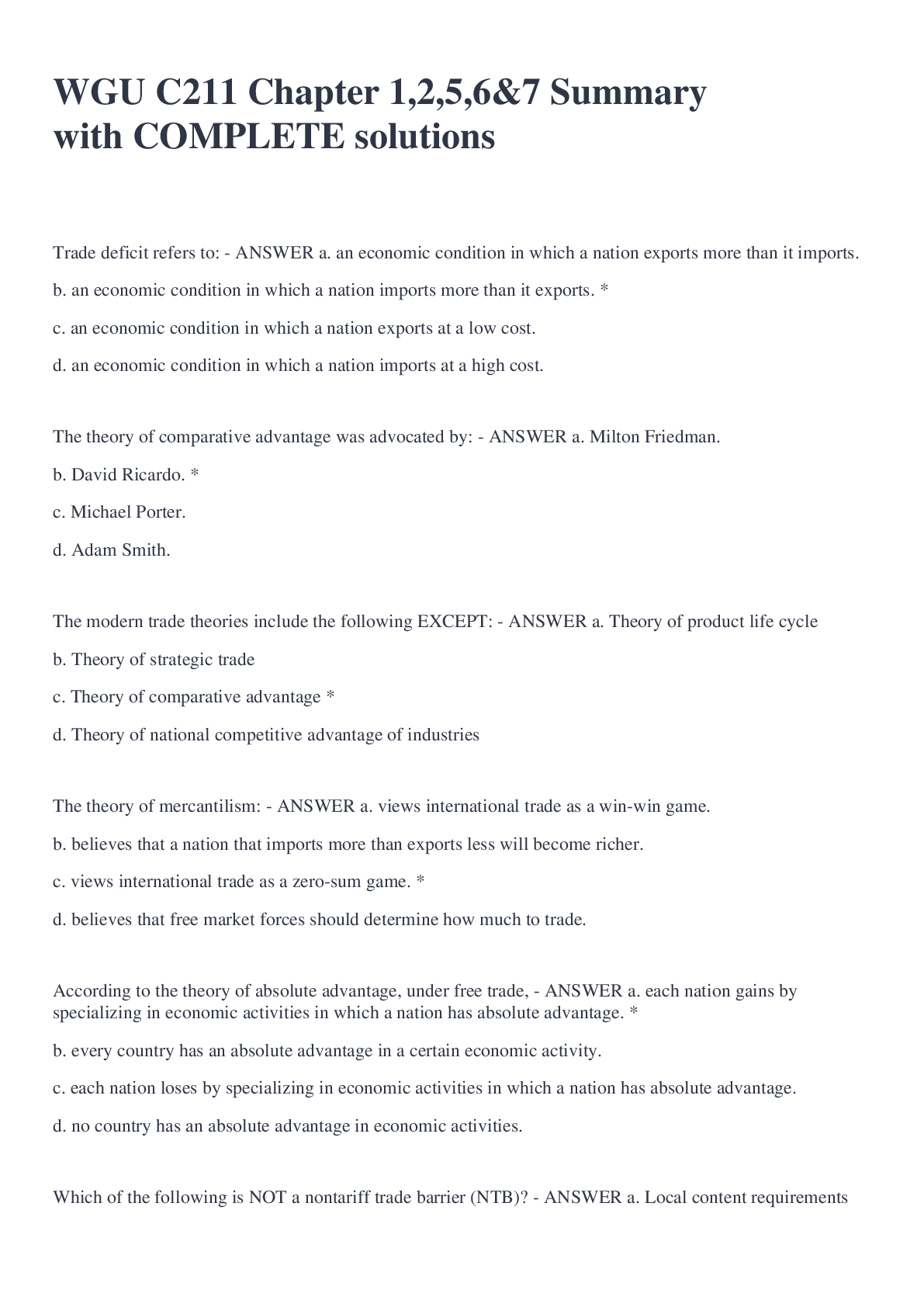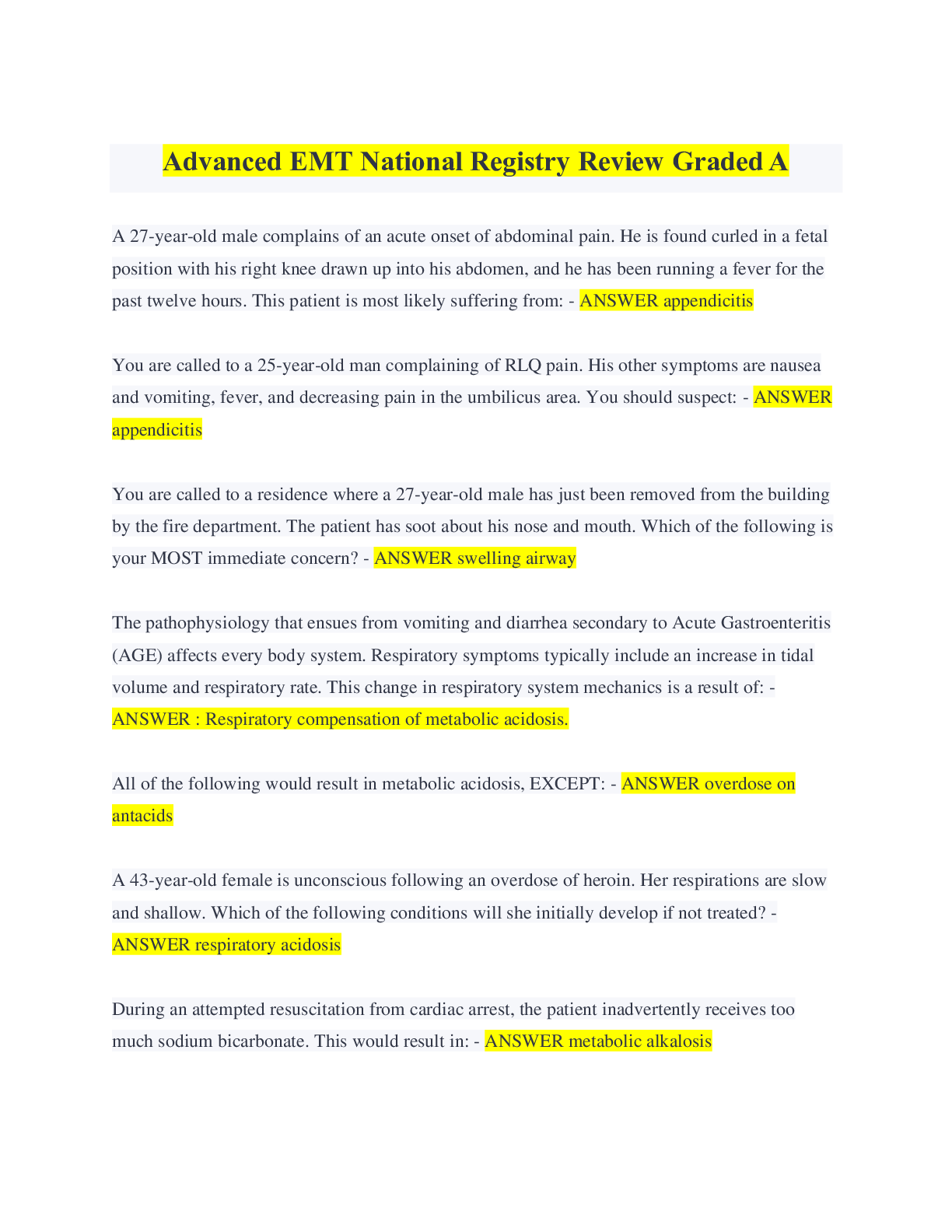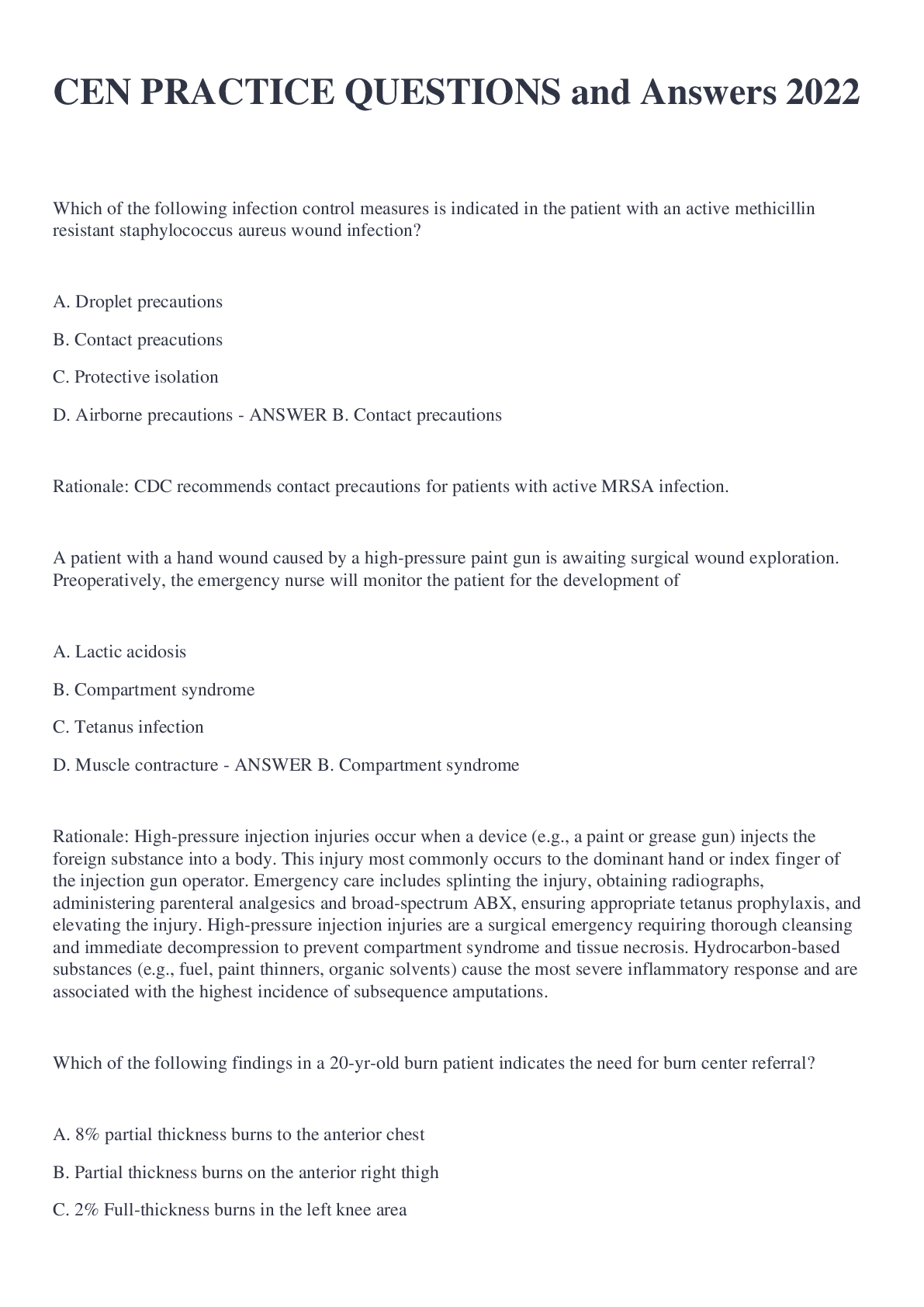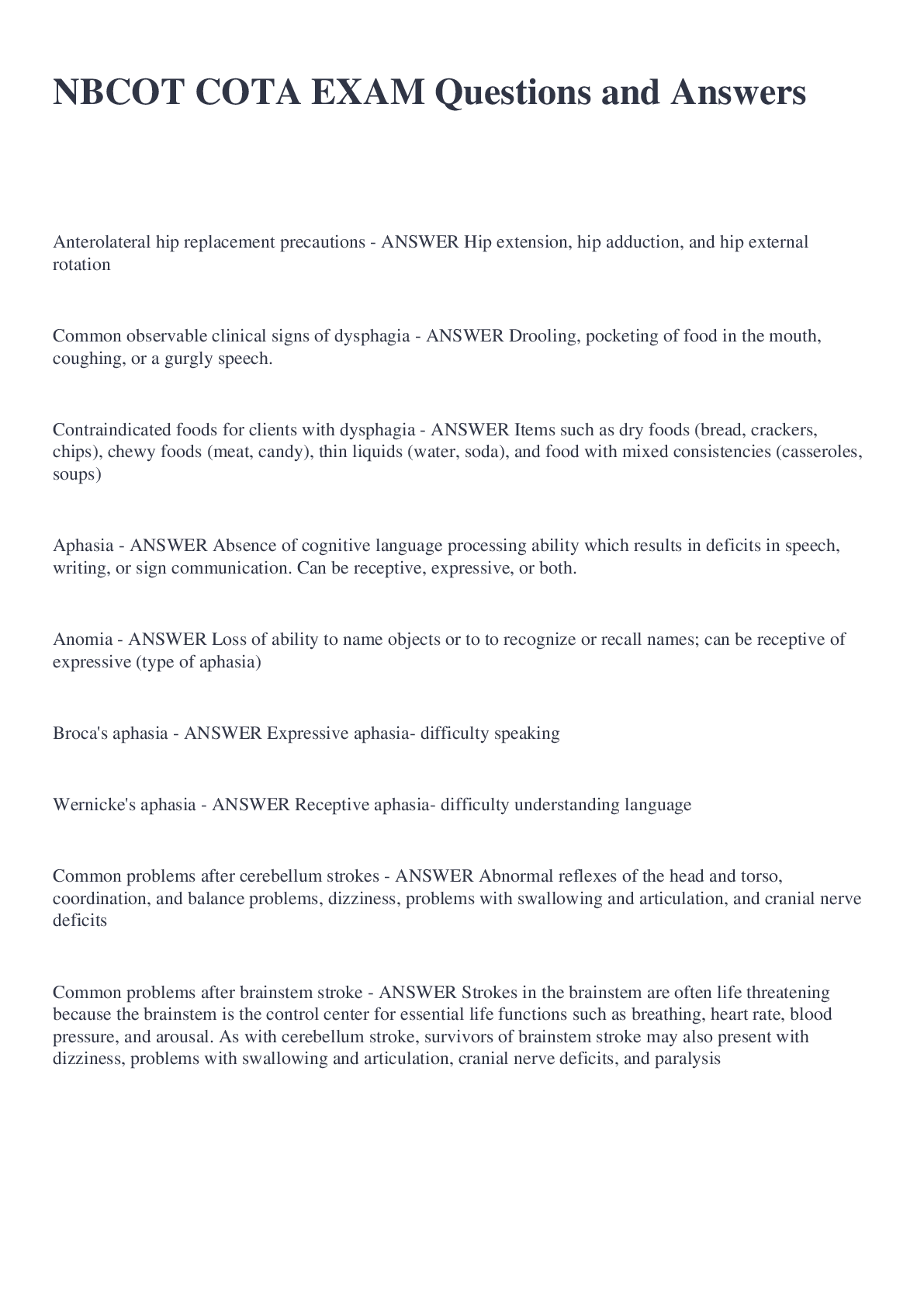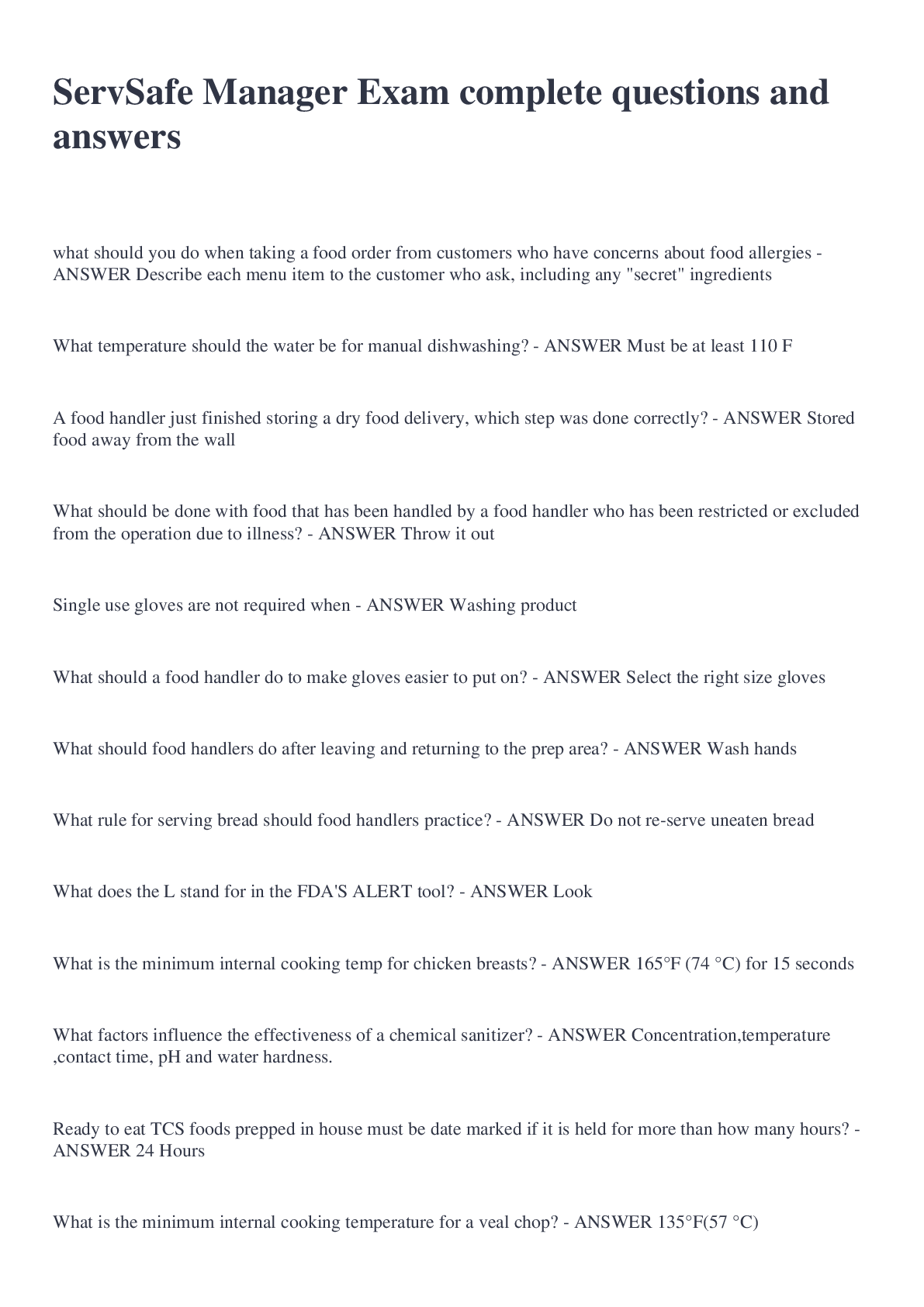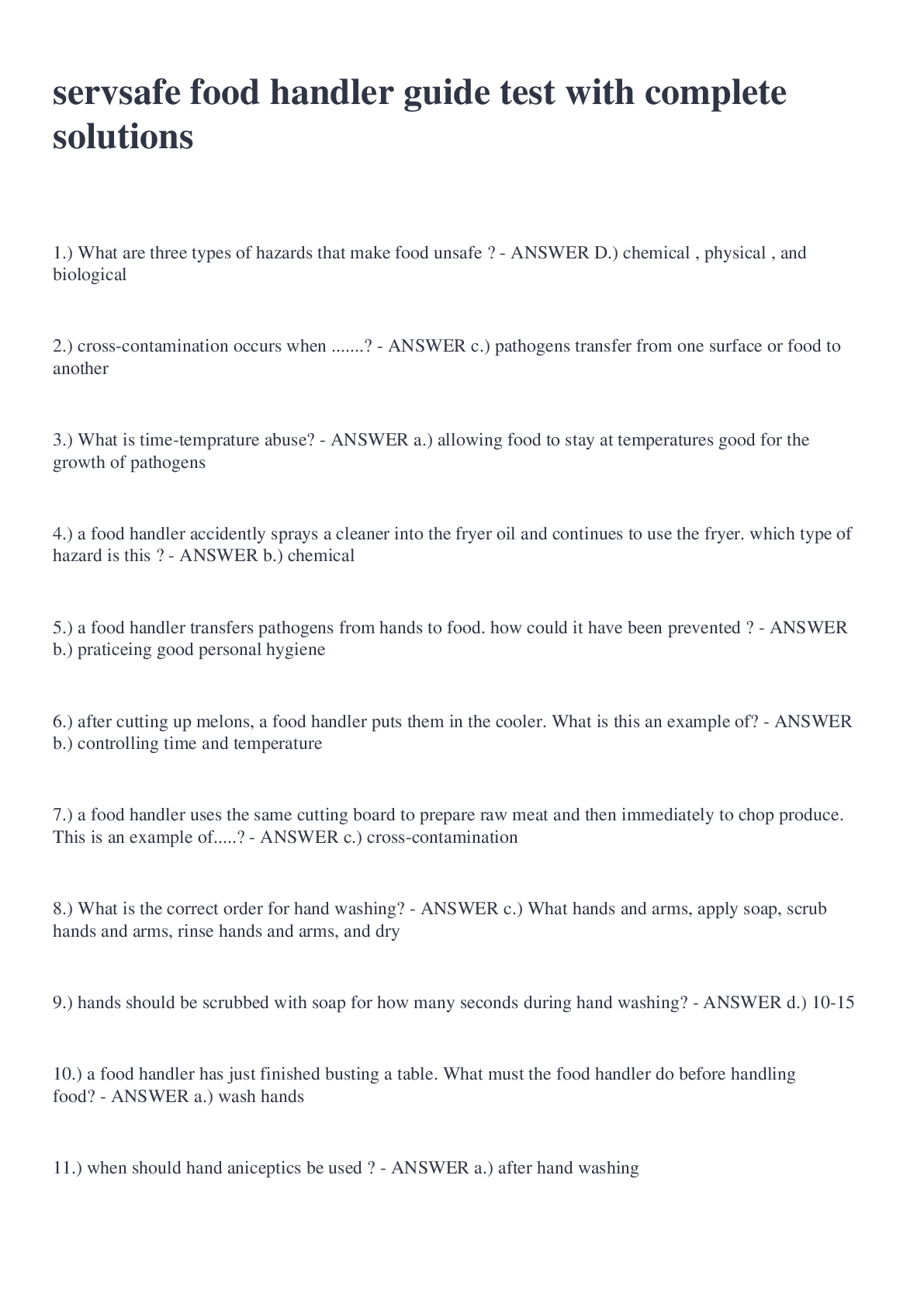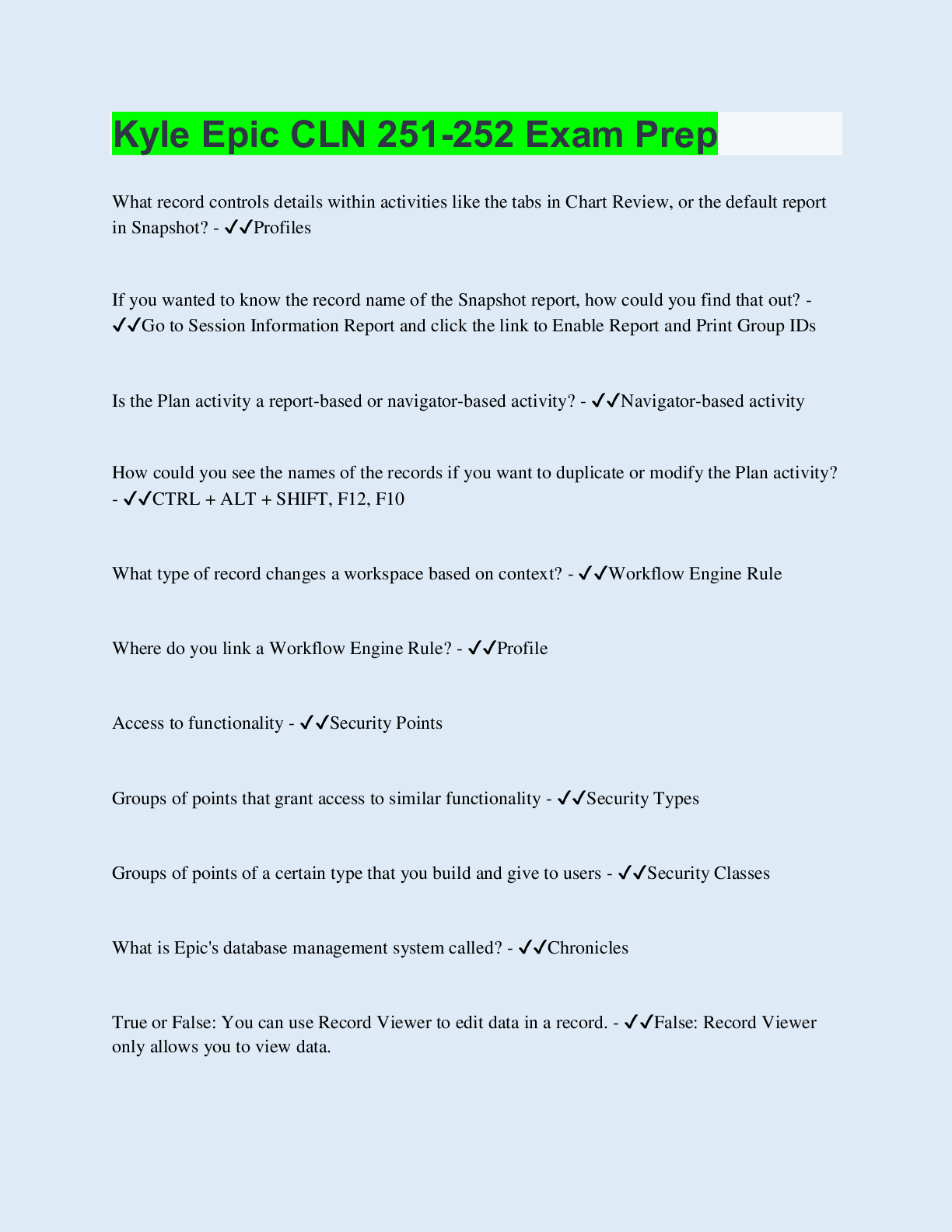CNPR Exam Questions and Answers
Document Content and Description Below
Margin of safety - ANSWER the difference between the usual effective dose and the dose that induces severe or life-threatening side effects Rights of drug administration - ANSWER right patient, rig... ht medication, right does, right route of administration, and right time of delivery Injection routes - ANSWER intramuscular, intrathecal, intravenous, subcutaneous intramuscular - ANSWER drugs given by direct injection into muscle tissue intrathecal - ANSWER needle is inserted between to vertebrea in the lower spine an into space around the spinal cord intravenous - ANSWER injected directly into the veins subcutaneous - ANSWER needle inserted into the fatty tissue just beneath the skin Bioavailablility - ANSWER how quickly and how much of a drug reaches its intended target site of action Bioequivalent - ANSWER when drugs contain not only the same active ingredients but also produce virtually the same blood levels over time Therapeutic equivalence - ANSWER production of the same medicinal effects Areas of drug elimination and excretion - ANSWER Lungs, breast milk, sweat tears urine feces, bile, saliva, and exhaled air medication error - ANSWER failure to administer drug in the correct form Powders - ANSWER a drug that is dried and ground into fine particles pills - ANSWER a single dose unit of medicine made by mixing the powdered drug with liquid such as syrup and rolling it into a round or oval shape granules - ANSWER a small pill usually accompanied usually accompanied by many others encased within a gelatin capsule; quite often releasing medication over time tablet - ANSWER pharmaceutical preparation made by compressing the powdered for of a drug and bulk filling material under high pressure; commonly used for anti acids and antiflatulents Capsules - ANSWER medication dosage form in which the drug is contained in an external shell; can be pulled apart for access to contents sustained release - ANSWER several doses of a drug in special coatings that dissolve at different rates Enteric Coating - ANSWER dosage in special coating that doesn't digest in the stomach; only starts to digest in the intestines caplets - ANSWER shaped like a capsule but has the form of a tablet the shape and file make swallowing easier gel caps - ANSWER an oil based medication that is enclosed in soft gelatin capsule Emulsion - ANSWER two agents that cannot ordinarily be combined or mixed otic drugs - ANSWER control localized infections or inflammation and require very low dosages to be effective Types of drug despensing - ANSWER OTC and prescription Type A (Augmented) drug reaction - ANSWER exaggeration of the drug's therapeutic effects Type B (idiosyncratic) - ANSWER results from mechanisms that are not currently understood; largely unpredictable Type C (continuing or chronic) - ANSWER These persist for a long time Type D delayed - ANSWER these take some time to develop Type E end of use - ANSWER These occur during drug withdrawal Risk Factors - ANSWER Use of several drugs, age, Pregnancy and breast feeding Excipients - ANSWER inactive ingredients Parenteral - ANSWER intravenous, intramuscular, subcutaneous Rectal - ANSWER suppository Oral - ANSWER tablet, capsule, liquid Transdermal - ANSWER through the skin via creams or patches Binders - ANSWER cement the active and inert components of tablets Fillers - ANSWER used to make the drug sufficiently large for easy manufacture and consumption Glidants(flow enhancers) - ANSWER added to powdered materials used in pill production to aid movement through tabletting machinery suspending/dispersing agents - ANSWER maintain consistent concentration of the active ingredients throughout the drug product disintegrants - ANSWER help break up the tablets int the GI tract Lubricants - ANSWER ease the release of the tablets from the dies that stamp them during the manufacturing process AUC - ANSWER represents the extent of the drug absorption or the quantity of the drug that appears in the bloodstream following oral administration Cmax - ANSWER peak plasma concentration on a measuring curve First pass effect - ANSWER metabolizing process in the liver that suppresses the amount of drug that eventually reaches the systemic circulation and the site of action onset of action - ANSWER the time it takes for a drug to start having any intended affect after it is administered Protein Binding - ANSWER the ability of certain drugs to bind to plasma protein QD - ANSWER once a day QID - ANSWER four times a day PRN - ANSWER take as needed TID - ANSWER three times a day Tmax - ANSWER time of peak plasma concentration on a measuring curve BID - ANSWER twice a day Authorized distributor - ANSWER any distributor of a prescription drug that has a written agreement with the manufacturers of the prescription drug and conducts at least two transactions with the manufacturer of the prescription drug within any 24-month period Average whole price (AWP) - ANSWER published whole sale price or list price suggested by the manufacturer Brokerage - ANSWER the combination of -drop ship and dock to dock delivery services provided by wholesalers. Wholesalers do not bring the product into their warehouses Buy-side margin - ANSWER refers to the early payment discounts and other earned or negotiated rebates and discounts received by wholesalers from drug manufacturers; increase in the value of wholesalers' inventories ad manufacturers' prices rise chain drug store - ANSWER a company that owns and operates four or more pharmacies dock to dock delivery - ANSWER wholesaler obtains the drugs to a dispenser own warehouse without taking the drugs into its own inventory drop shipment - ANSWER the drug manufacturer directly delivers the drugs to a dispenser but the order and payments are made through a wholesaler Float - ANSWER the time differential between when a wholesaler receives payment from its customer and when the payment is due to its supplier Group Purchasing Organization GPO - ANSWER an entity consisting of two or more hospitals or other healthcare entities that is formed to offer its members access to purchasing contracts for health supplies In-state wholesaler - ANSWER wholesaler that distributes drug products in a state in which it is physically located independent drug store - ANSWER a company that owns and operates three or fewer pharmacies Integrated Delivery Network IDN - ANSWER a financial management structure that unites hospitals, physicians ambulatory care site and managed care plans through ownership or exclusive formal agreements to provide a system to deliver a continuum of healthcare services Mail order pharmacy - ANSWER a pharmacy that dispenses prescriptions to patients who submit their prescriptions by mail or fax manufacturer direct sale - ANSWER the type of sale that bypasses the need for any intermediary distributor mass merchandiser - ANSWER Department stores with a pharmacy non-stock sales - ANSWER brokerage sales, dock to dock sales, drop shipments, and any form of sale not placed in inventory out of state wolesaler - ANSWER a wholesaler that distributes drug products in a state in which it is not physically located pharmacy benefit management group - ANSWER an entity that administers the prescription drug part of health insurance plans on behalf of plan sponsors such as self insured employers, insureance companies, and health maintenance organizations rebate - ANSWER the amount that the manufacturer of the drug pays to an insurer or health plan for each unit of drug dispensed self warehousing - ANSWER a type of distribution system where the retailer of the institutional dispenser takes on the task of distribution itself sell-side margin - ANSWER wholesaler revenues that are generated from fees and other charges obtained from dispensers Upcharge - ANSWER the percentage fee that is paid by the dispenser to the wholesaler for the cost of distribution Orphan Drug (ODE) ` - ANSWER 7 years exclusivity New Chemical entity - ANSWER 5 years exclusivity Other Exclusivity - ANSWER 3 years for a change if criteria are met Pediatric Exclusivity (PED) - ANSWER 6 months added to existing Patents/exclusivity Patent Challenge - ANSWER 180 days for ANDAs only Duration of a patent - ANSWER 20 years Package insert - ANSWER provide practitioners with essential information they need to prescribe the drug safely and effectively for the care of patients Orange Book - ANSWER list of approved drug products with therapeutic equivalence A OBR - ANSWER products for which there are no known or suspected bioequivalence problems AA OBR - ANSWER products in conventional dosage forms with no bioequivalence problems AN OBR - ANSWER solutions and powders AO OBR - ANSWER Injectable oil solutions AP - ANSWER injectable aqueous solutions AT - ANSWER topical products B - ANSWER drug products requiring further FDA investigation and review to determine equivalence ANDA - ANSWER abbreviated new drug application How many days does a brand name company have to sue - ANSWER 45 Generic drug first to file exclusivity - ANSWER the first generic drug manufacturer to file an ANDA with the FDA on a new off-patent drug receives a six-month marketing exclusivity Single-source drug products - ANSWER there is only one approved product available for that active ingredient and dosage form Multi-source drug prodcuts - ANSWER pharmaceutically equivalent products are available from more than one manufacturer Hatch Waxman act - ANSWER also known as the drug price competition and patent tem restoration act of 1984 most significant drug related legislation affecting pharmaceutical and healthcare industries since 1962 HW Act - ANSWER made it easier to bring generic drugs to the market by requiring the FDA to only look at bioavailability studies in order to approve an ANDA chemical equivalents - ANSWER multi-source products which contain essentially the same amounts of identical active ingredients in identical dosage forms which meet existing physical chemical standards Biological equivalents - ANSWER chemical equivalents which when administered in the same amount will provide same biological or physiological availability as measured by blood and urine levels therapeutic equivalents - ANSWER chemical equivalents which when administered in the same amount will provide same therapeutic effect as measured by the control of a symptom or disease generic substitution - ANSWER the act of dispensing a different brand for the product prescribed pharmaceutical alternatives - ANSWER drug products that have the same therapeutic effect and strength but differ in the salt, ester or dosage form and are administered by the same rout pharmaceutical substitution - ANSWER the act of dispensing a pharmaceutical alternative for the product prescribed Therapeutic alternatives - ANSWER drug products containing different therapeutic moieties but of the same pharmacological or therapeutic class can be expected to have similar therapeutic effects when administered in therapeutically equivalent doses PDMA - ANSWER product development and management association drug sample - ANSWER unit of drug not intended to be sold but to promote the sale Section 503 of Federal food drug and cosmetic act - ANSWER prohibits the sale, purchase, trade or offer to sell, purchase or trade prescription drug samples and coupons USP US pharmacopoeia - ANSWER the first comprehensive publication of drug standards USP-UF US Pharmacopoeia - National Formulary - ANSWER current annual publication of certified drug standards verifying purity and ingredients Office of inspector general - ANSWER an arm of the department of health and human services that investigates regulatory infractions, provides compliance advice and bring enforcement actions Federal trade commision - ANSWER regulates general business practices to protect consumers against misleading and anti-competitive behavior Drug enforcement administration - ANSWER regulates the distribution and use of narcotics and other controlled substances A patent owner has the right to exclude others from making, using, selling or importing into the US the ____ it describes. - ANSWER invention Which is not a rule in making the most out of your sales call? - ANSWER your agenda not theirs Clinical Pharmacology - ANSWER The study of the effects and movement of drugs in the human body The acronym for effective dose is: - ANSWER ed [Show More]
Last updated: 2 years ago
Preview 1 out of 23 pages

Buy this document to get the full access instantly
Instant Download Access after purchase
Buy NowInstant download
We Accept:

Reviews( 0 )
$6.00
Can't find what you want? Try our AI powered Search
Document information
Connected school, study & course
About the document
Uploaded On
Oct 06, 2022
Number of pages
23
Written in
Additional information
This document has been written for:
Uploaded
Oct 06, 2022
Downloads
0
Views
46

